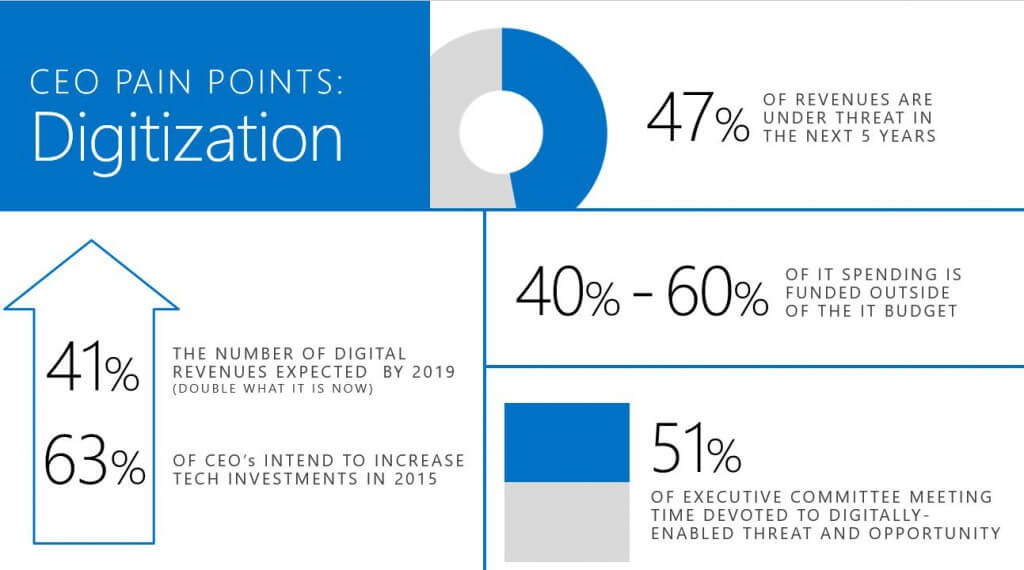Around the world, companies and organizations – and the IT leaders who support them – are urgently re-inventing their cultures, skills, and measures of success to respond to the challenges and opportunities presented by the digital revolution. It’s certainly the case at Microsoft. Not convinced? Read on.
Last month’s World Economic Forum in Davos, Switzerland, included a session called “Digital Transformation of Industries.”
The CEOs of multi-national companies discussed the implications of digitization for their customers and employees. The moderator framed the discussion around three angles:
The testimonies of CEOs at Davos are reflected in recent research from Gartner and MIT’s Center for Information Systems Research.

The digital economy creates daunting requirements for operational structures and business architecture, particularly for any established organization with legacy systems and infrastructure. In a pre-digital economy, we focused on process efficiency and effectiveness, and executed with a divide-and-conquer approach. In a digital economy, we architect for agility and new types of business models, we empower employees and customers to innovate at a pace unimaginable in earlier generations, and we embrace new values of building on top of others’ ideas and iterating rapidly.
As a result, the discussion around technology platforms is no longer confined to IT. Leaders from sales, marketing, support, human resources, and elsewhere view technology as a core part of innovating their processes. It’s up to IT leaders to help drive innovation across the full range of their companies’ operations, whether or not the IT organization actually owns the technology.
IT’s expanded role within Microsoft
In my two years as CIO, there have been five key learnings that have shaped the role of IT within the company.
First: How I spend my time. I’ve shifted more of my time away from managing IT to working with internal business leaders and external customers. This allows me to be a trusted ally to influence decisions and guide colleagues on best practices across the company. It also helps me guide my IT team towards more productive engagements with internal stakeholders. Much of that influence and guidance is based on Microsoft IT’s experience as the first customer of Microsoft’s products and services, and my time helping customers respond to their own opportunities and challenges.
Second: The shift to IT services. My IT team used to think in terms of projects and applications, and now we think in terms of service offerings. Each service offering represents all of the technology investments that support an end-to-end business process, such as product development, sales, or customer support. Conversations about IT used to be disconnected from conversations about the Microsoft business. Now, we talk about which investments will improve our service offerings. With a service offering model, IT is directly engaged in business value. We’ve been able to remove time out of the process, and remove opportunities for miscommunication, which gives us the capacity to deliver faster.
Third: Break down barriers and be transparent. Because IT can see across the business processes, it’s our responsibility to influence investment priorities and not just execute on priorities set by our internal business stakeholders. It’s our job to connect and coordinate processes and digital capabilities across the company to realize more value, even when those capabilities represent employee innovation outside of IT. As IT becomes more central to business strategy, the need for transparency increases.
How do we help stakeholders and business leaders deal with digital issues? These three items have made a difference: (1) transparent and accessible IT dashboards; (2) clear IT governance; and (3) regular reporting on cyber security.
To further accelerate our pace we use cloud solutions whenever possible. When we needed a third-party electronic signature solution, a voice analytics solution, or IT analytics solution, we opted for SaaS offerings. We’re rapidly moving internal line-of-business applications to Microsoft Azure, which allows us to modernize our engineering practices.
Fourth: Use analytics. Telemetry allows us to see how data is flowing through systems and how people are using tools and processes. So when our internal business partners say, “This new capability will give us this business benefit,” our technical people can say, “I can see how that would work in the system.” We make a significant investment to help enable our employees with self-service business intelligence (BI) tools so they can glean new insights while sharing and re-using data common across the business, with a low learning curve and a minimum of bottlenecks.
Fifth: Demonstrate and nurture the culture. For us, this means ingraining Microsoft’s emerging corporate culture and core values into employees’ ways of working. If we get the culture right then we can implement anything; without the culture in place, we can develop strategy all day long and we’ll only see poor results. For example, when it comes to IT investments, we tell our people that they share accountability for the business outcome, even if the IT resources are controlled by another department. It’s a new, growth-based mindset that embraces learning and extends the role of IT beyond the organizational boundaries of IT. We’re one Microsoft now, and our job is to make a difference in the lives of our customers.
For more information: